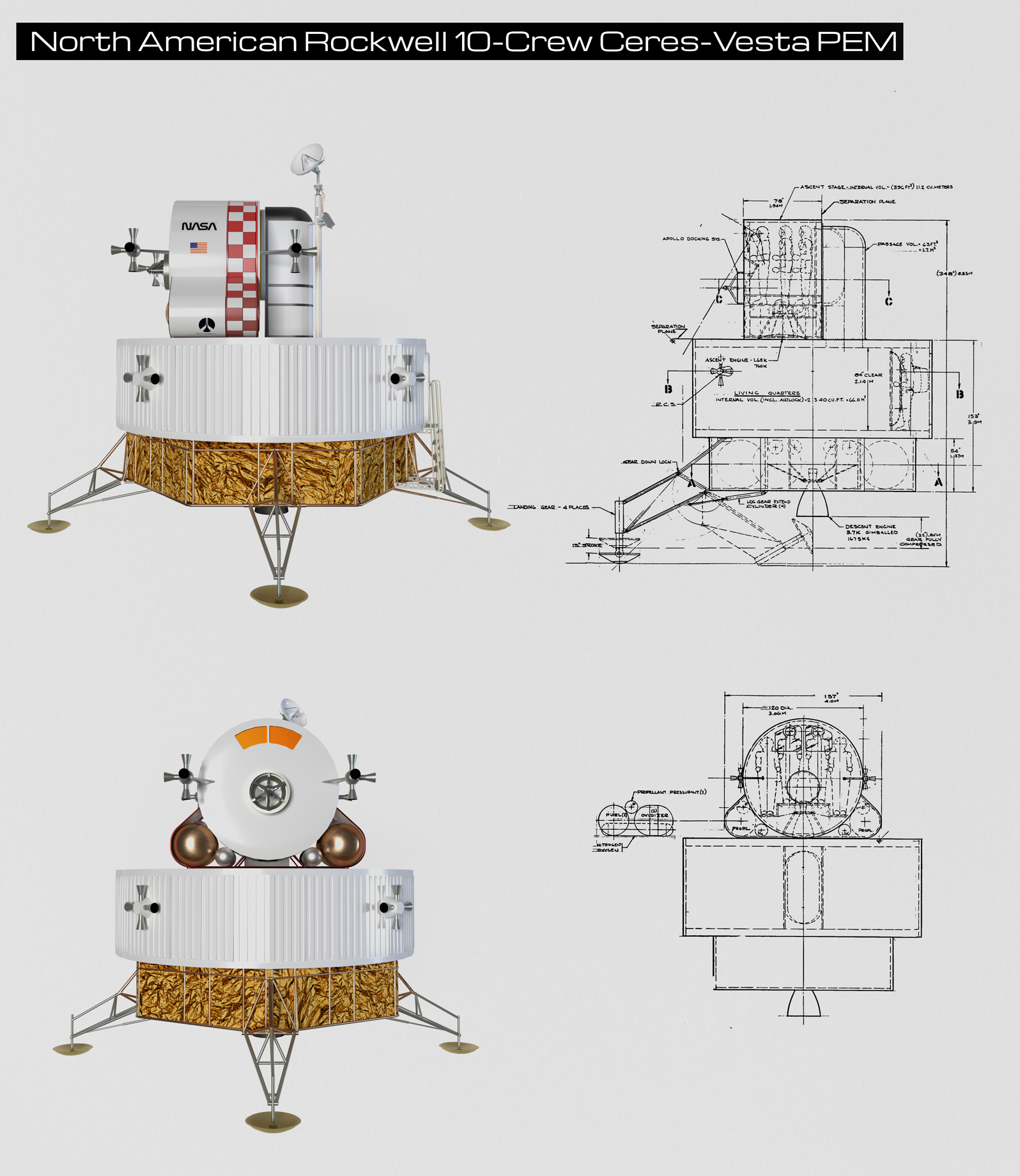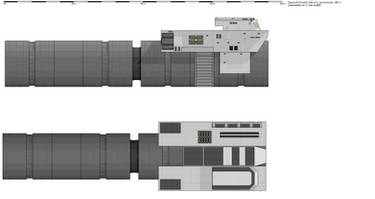ShopDreamUp AI ArtDreamUp
Deviation Actions
Description
The full size, full resolution, artwork is presently available to my patrons at Patreon.com/WilliamBlack.
The design is from Technological Requirements Common to Manned Planetary Missions: Appendix D by the space division of North American Rockwell, circa 1965, which details Planetary Excursion Modules (PEM).
Atomic Rockets Link 10-Crew Ceres-Vesta PEM
Note:This is the full landing stage, including Descent Stage, Crew Habitat for a 30-day surface stay, and Ascent Stage. For the detailed model of the Ascent Stage click the following link: Ceres-Vesta PEM Ascent Module
The study included 3- and 10-man vehicles for nonatmospheric planetary bodies, such as might be required for theoretical manned missions to Ceres and Vesta, Jupiter's moon Ganymede, and Mercury. These airless body retropropulsion excursion modules are based on the Apollo Lunar Excursion Module with an Ascent Stage on top of a Descent Stage. These landing craft were slated to be carried by nuclear thermal interplanetary exploration missions. They are designed for a nominal 30 day stay on the planetary surface, before returning to orbit.
The mission quarters compartment has been configured to be a cylindrical section 6.1 meters (240 inches) in diameter with flat ends with an internal clear ceiling height of 2.14 meters (84 inches). The gross mold line pressurized volume of the compartment is 66 cubic meters (2,340 cubic feet). The compartment is positioned symmetrically on top of the descent stage and is provided with an internal cylindrical airlock to facilitate access to the target body surface by a ladder.
The ascent stage is located on top of the mission quarters, offset to provide adequate down visibility to the operating crew for landing site assessment prior to touchdown.
The 10-man crew is accommodated in a standing position during descent and ascent, probably secured by harnesses, in a 3.06 meter (120 inch) diameter cylindrical pressurized compartment 1.98 meters (78 inches) long.
Winchell Chung: “They do, however, have Rockwell's fixation on using the insanely dangerous FLOX as an oxidizer, and the only somewhat dangerous Monomethylhydrazine (MMH) as fuel. The reason is that liquid hydrogen requires preposterously huge tanks, but if you use anything else the specific impulse goes way down. Unless you take the mad-scientist step of using FLOX oxidizer to make up for it.”
Related Art:
Ceres-Vesta PEM Ascent Module
Ceres Descent
Ceres EVA
The design is from Technological Requirements Common to Manned Planetary Missions: Appendix D by the space division of North American Rockwell, circa 1965, which details Planetary Excursion Modules (PEM).
Atomic Rockets Link 10-Crew Ceres-Vesta PEM
Note:This is the full landing stage, including Descent Stage, Crew Habitat for a 30-day surface stay, and Ascent Stage. For the detailed model of the Ascent Stage click the following link: Ceres-Vesta PEM Ascent Module
The study included 3- and 10-man vehicles for nonatmospheric planetary bodies, such as might be required for theoretical manned missions to Ceres and Vesta, Jupiter's moon Ganymede, and Mercury. These airless body retropropulsion excursion modules are based on the Apollo Lunar Excursion Module with an Ascent Stage on top of a Descent Stage. These landing craft were slated to be carried by nuclear thermal interplanetary exploration missions. They are designed for a nominal 30 day stay on the planetary surface, before returning to orbit.
The mission quarters compartment has been configured to be a cylindrical section 6.1 meters (240 inches) in diameter with flat ends with an internal clear ceiling height of 2.14 meters (84 inches). The gross mold line pressurized volume of the compartment is 66 cubic meters (2,340 cubic feet). The compartment is positioned symmetrically on top of the descent stage and is provided with an internal cylindrical airlock to facilitate access to the target body surface by a ladder.
The ascent stage is located on top of the mission quarters, offset to provide adequate down visibility to the operating crew for landing site assessment prior to touchdown.
The 10-man crew is accommodated in a standing position during descent and ascent, probably secured by harnesses, in a 3.06 meter (120 inch) diameter cylindrical pressurized compartment 1.98 meters (78 inches) long.
Winchell Chung: “They do, however, have Rockwell's fixation on using the insanely dangerous FLOX as an oxidizer, and the only somewhat dangerous Monomethylhydrazine (MMH) as fuel. The reason is that liquid hydrogen requires preposterously huge tanks, but if you use anything else the specific impulse goes way down. Unless you take the mad-scientist step of using FLOX oxidizer to make up for it.”
Related Art:
Ceres-Vesta PEM Ascent Module
Ceres Descent
Ceres EVA
Image size
1596x1840px 864.55 KB
© 2016 - 2024 William-Black
Comments1
Join the community to add your comment. Already a deviant? Log In
Heh, I occasionally go to Atomic Rockets for advice when i have a space flight question. Nice to see your work there.











![Tiangong-1 and Shenzhou-9 Tech Readout [new]](https://images-wixmp-ed30a86b8c4ca887773594c2.wixmp.com/f/e0dc8eb0-7eb3-4716-b7a1-4364a45acdc0/d7ro48p-f8561e99-2bcf-4dc5-b260-ec27f04fdebf.jpg/v1/crop/w_184)
![MAKS Multipurpose Aerospace System ortho [1] [new]](https://images-wixmp-ed30a86b8c4ca887773594c2.wixmp.com/f/e0dc8eb0-7eb3-4716-b7a1-4364a45acdc0/d7qh57x-abbc03c5-45f8-4d42-869c-a4efdafce108.jpg/v1/crop/w_184)























